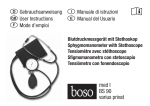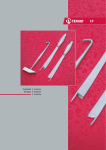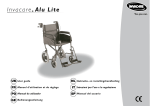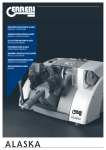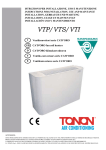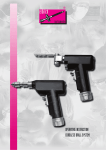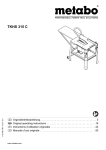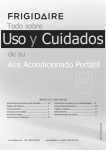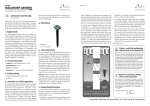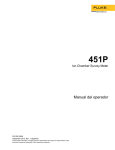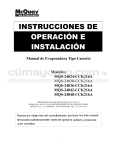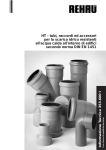Download Plaster Saw „Oscillotronic 500“ - Berger
Transcript
NEW GEN ERA TIO N erbrich Gipssäge erbrich Plaster Saw Oscillotronic 500 17E Oscillierende Gipssäge Oscillating Plaster Saw Oscillotronic 500 • 500 Watt Leistung • 500 Watt power • 6500 bis 24000 Schwingungen, stufenlos regelbar • 6500 to 24000 oscillations, steplessly adjustable • Vollautomatische Lastkompensation über den • Full-automatic power-compensation, i.e. a once gesamten Schwingungsbereich, d. h. eine chosen oscillation stays during the whole power- eingestellte Schwingung compensation bleibt über den gesamten Lastbereich erhalten • Schlanke Motorausführung mit sehr ruhigem Lauf ca. 52 – 77 db(A) in Abhängigkeit der eingestellten Schwingung • Modernste Motorelektronik mit diversen Sicherheits- und Schutzfunktionen • Sanftanlauf beim Einschalten, vermindert Unfallgefahr und schont alle mechanischen und elektronischen Bauteile • Robuste Konstruktion für höchste Belastbarkeit im Dauerbertrieb • Sicherheits-EIN-AUS-Schalter • Gewicht nur 1,25 kg ohne Kabel (1,5 kg mit Kabel) • Slender motor body with a silent operation running, 52 – 77 dB(A) in relation to the selected oscillations • Latest electronic system with various protection and security functions • Gently slow starting prevents accidents and treats all mechanical and electronic parts with care • Strong construction for highest stress at non-stop operation • Safety ON / OFF switch • Weight only 1,25 kg without cable (1,5 kg with cable) • Vibration-free and low-maintenance • The regulation of the motor performance is on the rear of the motor and therefore won’t disturb the • Vibrations- und Wartungsarm user during his work. Once selected the oscillations • 1 Jahr Garantie auf Motor und Antriebseinheit will remain constant. (bei sachgerechter Behandlung), 2 Jahre Gewährleistung • Regelung außerhalb des Handbereiches, dadurch keine unbeabsichtigte Verstellung der eingestellten Schwingung • 5 Meter Euroflachsteckerkabel bei der 230 Volt Version oder 3 Meter USA-Steckerkabel bei der 110 Volt Version • Spezielle Motorlagerung (Gipsstaubgeschützt) und verstärkte Ankerwelle • Doppelschutzisoliert, Motor entspricht Schutzklasse II und medizinischer Anwendungsteil entspricht Typ BF • Bild- und Tonfunkentstört • CE-Konform • Geprüft nach EN 60601-1, EN 60601-1-2, IEC 60601-1, IEC 60601-1-2 • 5 meter cable with EU-connection, 230 Volt version or 3 meter cable with US-connection, 110 Volt version • Special positioning of the motor, protected from plaster dust • Double protection isolation, motor according to class II, medical use of type BF • Free from interference • CE conformity • Approved according EN 60601-1, EN 60601-1-2, IEC 60601-1, IEC60601-1-2 Oscillierende Gipssäge Oscillating Plaster Saw 17E Technische Daten Technical Data 110 Volt 110 Volt 110 V ~, 60 Hz 110 V ~, 60 Hz Leistung 500 W Power 500 W 6.500 – 24.000 Schwingungen / min 6.500 – 24.000 oscillations / min Stufenlos regelbar steplessly adjustable 3 Meter USA-Steckerkabel 3 meter cable with USA-plug 230 Volt 230 Volt 230 V ~, 50 Hz 230 V ~, 50 Hz Leistung 500 W Power 500 W 6.500 – 24.000 Schwingungen / min 6.500 – 24.000 oscillations / min Stufenlos regelbar steplessly adjustable 5 Meter Euroflachsteckerkabel 5 meter cable with EURO-plug Bestelldaten Ordering Data Gipssäge, komplett mit Zubehör: Plaster-Saw, complete with Accessories: + 1 Sägeblatt Ø 50 mm + 1 Saw Blade Ø 50 mm + 1 Sägeblatt Ø 65 mm + 1 Saw Blade Ø 65 mm + 1 Paar Gabelschlüssel + 1 Pair of Wrenches + Kabel + Cable 17E-035.11 110 Volt, 500 Watt 17E-036.11 mit Koffer / with Case 17E-035.23 230 Volt, 500 Watt 17E-036.23 mit Koffer / with Case Gipssäge, für synthetischen Gips Plaster-Saw, for syntetic Plaster komplett mit Zubehör: complete with Accessories: + 1 Sägeblatt Ø 50 mm + 1 Saw Blade Ø 50 mm + 1 Sägeblatt Ø 65 mm + 1 Saw Blade Ø 65 mm + 1 Paar Gabelschlüssel + 1 Pair of Wrenches + Kabel + Cabel 17E-037.11 110 Volt, 500 Watt 17E-038.11 mit Koffer / with Case 17E-037.23 230 Volt, 500 Watt 17E-038.23 mit Koffer / with Case 17E Sägeblätter Saw Blads Ø 50 mm Bestelldaten Ordering Data 17E-040.50 17E-040.50 Sägeblatt für normalen Gips Saw Blade for normal Plaster 17E-041.50 17E-041.50 Sägeblatt für sythetischen Gips Saw Blade for synthetic Plaster 17E-040.65 17E-040.65 Sägeblatt für normalen Gips Saw Blade for normal Plaster 17E-041.65 17E-041.65 Sägeblatt für sythetischen Gips Saw Blade for synthetic Plaster 17E-050.01 17E-050.01 Sägeblatt für normalen Gips Saw Blade for normal Plaster 17E-051.01 17E-051.01 Sägeblatt für sythetischen Gips Saw Blade for synthetic Plaster Ø 65 mm Ø 65 mm Sägeblätter Saw Blads 17E Bestelldaten Ordering Data 17E-050.02 17E-050.02 Sägeblatt für normalen Gips Saw Blade for normal Plaster 17E-051.02 17E-051.02 Sägeblatt für sythetischen Gips Saw Blade for synthetic Plaster 17E-050.03 17E-050.03 Sägeblatt für normalen Gips Saw Blade for normal Plaster 17E-051.03 17E-051.03 Sägeblatt für sythetischen Gips Saw Blade for synthetic Plaster 17E-055.00 17E-055.00 Begrenzungsscheibe Distance disk 17E-057.00 17E-057.00 Sägeblatt für Stryker Saw Blade for Stryker Ø 65 mm Ø 70 mm 17E Sägeblätter, Vielzahn Saw Blads, Multiteeth Ø 50 mm Bestelldaten Ordering Data 17E-060.50 17E-060.50 Sägeblatt für normalen Gips Saw Blade for normal Plaster 17E-061.50 17E-061.50 Sägeblatt für sythetischen Gips Saw Blade for synthetic Plaster 17E-060.65 17E-060.65 Sägeblatt für normalen Gips Saw Blade for normal Plaster 17E-061.65 17E-061.65 Sägeblatt für sythetischen Gips Saw Blade for synthetic Plaster 17E-065.01 17E-065.01 Sägeblatt für normalen Gips Saw Blade for normal Plaster 17E-066.01 17E-066.01 Sägeblatt für sythetischen Gips Saw Blade for synthetic Plaster Ø 65 mm Ø 65 mm Sägeblätter, Vielzahn Saw Blads, Multiteeth 17E Bestelldaten Ordering Data 17E-065.02 17E-065.02 Sägeblatt für normalen Gips Saw Blade for normal Plaster 17E-066.02 17E-066.02 Sägeblatt für sythetischen Gips Saw Blade for synthetic Plaster 17E-065.03 17E-065.03 Sägeblatt für normalen Gips Saw Blade for normal Plaster 17E-066.03 17E-066.03 Sägeblatt für sythetischen Gips Saw Blade for synthetic Plaster Ø 65 mm Ø 70 mm Gipssäge „Oscillotronic 500“ Gebrauchsanweisung Die Gipssäge „Oscillotronoc 500“ ist eine oszillierende Gips- und Kunststoffsäge zum Auftrennen von Gips- und Kunststoff-Hartverbänden. Bei normaler Gipsstärke kommt das Sägeblatt mit Durchmesser 50 mm zur Anwendung. In Ausnahmefällen und dementsprechender Gipsstärke kommt das Sägeblatt mit Durchmesser 65 mm zur Anwendung. Für das sachgerechte auswechseln der Sägeblätter verwenden Sie bitte mitgelieferte Gabelschlüssel. Es ist darauf zu achten, daß beim Wechseln kein Überdrehen des Exzenters erfolgt. Um eine Überbelastung und starke Erwärmung des Gerätes zu vermeiden, empfehlen wir, stumpfe und abgenützte Sägeblätter rechtzeitig auszuwechseln. Sägeblätter besitzen scharfe Schneidkanten. Dies ist sowohl beim Auswechseln der Blätter als auch im Betrieb immer zu berücksichtigen. Vorsicht Verletzungsgefahr ! Beim Auftrennen von normalen Naturgipsverbänden sind Sägeblätter für Naturgips (glänzende Oberflächenstruktur) einzusetzen. Bei synthetischen Hartverbänden sind Sägeblätter für Kunststoffverbände (matte Oberflächenstruktur) anzuwenden. Beim Auftrennen von synthetischen Verbänden entsteht mehr Reibungswärme. Dadurch neigen die Sägespäne zum Verkleben mit dem Sägeblatt. Dieses verkleben wird mit Sägeblätter für Kunststoffverbände durch eine spezielle Beschichtungsoberfläche weitestgehend minimiert. Die Säge und das Sägeblatt sollten nach Gebrauch mit einem sauberen und trockenem Tuch von Staub und ähnlichem gereinigt werden. Die Säge darf nicht in Flüssigkeiten (Wasser, etc.) eingelegt oder mit dergleichen gewaschen oder benetzt werden. Sollte eine Desinfektion erforderlich sein, so darf sie nur mit vorschriftsmäßig verdünnten und handelsüblichen Desinfektionsmittel vorgenommen werden. Die Säge darf dabei nur mit einem feuchten Tuch abgewischt werden (nicht benetzen). Es ist unbedingt darauf zu achten, daß keine Flüssigkeiten oder Dämpfe in das Gerät eindringen. Bei sämtlichen Reinigungen ist das Gerät vom Netz zu trennen (Netzstecker ziehen). Die Säge darf nicht sterilisiert werden. Das Gerät ist wartungsfrei. In Bereichen, in denen Explosiongefahr besteht, darf die Gipssäge nicht angewendet werden. Vor jeder Benützung muß die Säge auf mechanische Schäden untersucht werden. Des weiteren darf die Säge nicht mehr benützt werden, sondern muß an uns zur Überprüfung eingeschickt werden, wenn sie auf den Boden gefallen ist. Reparaturen dürfen nur bei uns durchgeführt werden. Bitte keine Reparaturversuche durchführen, da durch unsachgemäße Ausführung weitere Defekte entstehen können und zudem der Garantieanspruch erlischt. Die Entsorgung des Gerätes am Ende der Gerätelebensdauer kann entweder durch uns oder andere, im Hinblick auf sachgerechte Entsorgung, erfolgen. Stumpfe Sägeblätter sind in den Wertstoffkreislauf einzubringen (Stahl- bzw. Metallwertstoff). Die Gipssäge wird mittels eines Sicherheits-EIN-AUS-Schalters ein- bzw. ausgeschaltet. Beim Einschalten der Gipssäge entsteht kurzzeitig ein hoher Anlaufstrom, die Elektronik verhindert, daß die Sicherung anspricht (Anlaufstrombegrenzung). Nach dem Hochfahren auf die eingestellte Schwingung steht die volle Motorleistung zur Verfügung. Durch das sanfte „Hochfahren“ der Gipssäge werden alle mechanischen sowie elektronischen Bauteile der Gipssäge geschont. Der ruckfreie Anlauf vermindert ebenfalls die Unfallgefahr. Mittels einer Sicherheitsschutzschaltung ist gewährleistet, daß zu keiner Zeit eine Überlastung des Motors stattfinden kann. Sollte trotzdem eine Überlastung des Motors stattfinden, z. B. durch blockieren des Antriebes, schaltet sich der Motor automatisch ab. Durch die Sicherheitsschaltung kann das Gerät nach kurzer Zeit wieder vollautomatisch in Betrieb genommen werden. Die Gipssäge hat die Anforderung der EMV Norm – EN 60601-1-2 erfüllt. Die Motorregelung befindet sich außerhalb des Handbereiches am hinteren Ende des Motors (neben der Kabelzuführung) und stört den Anwender somit nicht beim Auftrennen des Verbandes. Am Regelrad kann eine Schwingungszahl von 6500 bis 24000 stufenlos eingestellt werden. Diese eingestellte Schwingung wird im Leerlauf und unter Last d. h. beim Auftrennen immer konstant gehalten. Die Lastkompensation ist auch bei unterschiedlichen Lastfällen immer aktiv und regelt dementsprechend die Schwingungen nach. Der Tachogenerator auf der Motorwelle registriert bei steigender Belastung des Motors einen unerwünschten Schwingungsabfall. Über den Sollwertvergleich wird die Schwingungszahl mit dem eingestellten Wert am Regelrad ständig nachgeregelt. Fällt die Schwingungszahl infolge plötzlicher Mehrbelastung unter den eingestellten Wert, so regelt die Elektronik so lange nach bis die eingestellte Schwingungszahl wieder erreicht wird. Dieser Vorgang ist so schnell, daß für den Anwender keine Schwingungszahl-Schwankungen unter Last erkennbar sind. So bleibt im Belastungszustand immer die optimale Schwingung erhalten. Bei übermäßiger Belastung des Motors (blockieren des Sägeblattes) schaltet die Elektronik die Säge aus und kann nach kurzer Zeit wieder in Betrieb genommen werden. erbrich-instrumente GmbH Eugenstr. 33, D 78532 Tuttlingen / Germany, Tele.: ++ 49 (0) 7461 965730 Rev. Stand 8/2003/1 F:\QM\Manual\Osc500d Gipssäge „Oscillotronic 500“ Durch den Einsatz modernster Elektronik und Bauteilen konnte ein sehr schlanker Motor mit einem sehr handhabungsfreundlichen Gehäusekopf entwickelt werden, wobei auch Gesichtspunkte hinsichtlich Ergonomie und Anthropologie, z. B. der Handhabung der Gipssäge bei kleinen Händen eingeflossen sind oder Geräuschminimierung während dem Gipssägeneinsatz, um Kindern die Angst vor dem Auftrennen des Verbandes zu nehmen (Regelung auf eine untere Schwingungszahl empfohlen). Die Umgebungstemperaturen für Transport und Lagerung sollten 5°C nicht unterschreiten und 40°C nicht überschreiten. Ebenfalls sollte die Luftfeuchtigkeit von 80% nicht überschritten werden. Technische Daten / Klassifikation Art.-Nr. 17E-035.23 / 17E-037.23, Gipssäge = 230 V, 50 Hz, 500 W Art.-Nr. 17E-035.11 / 17E-037.11, Gipssäge = 110 V, 60 Hz, 500 W Geräte entsprechen der Schutzklasse II und der Anwendungsteil entspricht dem Typ BF. Technische Spezifikation - 230 V, 50 Hz, 500 W oder 110 V, 60 Hz, 500 W - Stufenlos regelbar von 6500 bis 24000 Schwingungen, Regelung außerhalb des Handbereiches - Vollautomatische Lastkompensation über den gesamten Schwingungsbereich - Modernste Motorelektronik mit diversen Schutz- und Sicherheitsfunktionen - 5 Meter Euroflachsteckerkabel bei 230 Volt Netzspannung oder 3 Meter USA-Flachsteckerkabel bei 110 Volt Netzspannung - Spezielle Motorlagerung, Gipsstaubgeschützt - Verstärkte Ankerwelle - Schlanke Motorausführung mit sehr ruhigem Lauf ca. 52 – 77 dB(A) in Abhängigkeit der eingestellten Schwingung Pos. Ersatzteile und empfohlenes Zubehör 1 1 Stück Befestigungsschraube für Sägeblatt 2 1 Stück Festhaltering für Sägeblatt 3 1 Ersatzsägeblatt, Kunststoffverband, 50 mm 4 1 Ersatzsägeblatt, Kunststoffverband, 65 mm 5 1 Ersatzsägeblatt, Naturgips, 50 mm 6 1 Ersatzsägeblatt, Naturgips, 65 mm 7 1 Paar Gabelschlüssel Symbole Doppelschutzisolierung Schutzklasse II Medizinischer Anwendungsteil des Typs BF ~ Wechselstromzeichen Konformitätszeichen 0/1 Aus- oder Einschaltzustand der Gipssäge erbrich-instrumente GmbH Eugenstr. 33, D 78532 Tuttlingen / Germany, Tele.: ++ 49 (0) 7461 965730 Rev. Stand 8/2003/1 F:\QM\Manual\Osc500d Plaster Saw „Oscillotronic 500“ Instruction Manual The plaster saw „Oscillotronic 500” is an oscillating saw for natural- and synthetic plaster dressings. In the case of an average plaster size, the 50mm saw blade should be used. In exceptional cases and if the plaster is thicker, the 65mm saw blade is required. For proper changing of the saw blades please use the attached wrenches. It is important that the excenter is not overstrained. In order to avoid wear and tear as well as any heating of the saw, we highly recommend replacing worn and blunt saw blades in time. Please be aware, that saw blades have sharp cutting edges. This has to be considered during use as well as when replacing them. Caution of injuries! In case of natural plasters (shiny surface) the appropriate saw blade for natural plasters should be used. In case of synthetic plaster dressings (silky surface) the saw blades for synthetic material should be used. As by cutting synthetic plasters more frictional heat is caused the shavings tend to stick to the saw blade. This effect can be abolished by using specially designed saw blades for synthetic plasters. Those blades have a special surface treatment. After use any dust or similar should be wiped off the saw and the blade with a dry cloth. The saw should not be soaked in any liquids (like water etc.) or be washed or even covered on. If disinfection is required, it has to be carried out by using appropriate diluted disinfecting solutions. The saw should be only wiped by a damp cloth (do not cover it). It is important that no liquids or steam enter the equipment. Please unplug the saw before cleaning. The saw should not be sterilized. The saw is maintenance-free. The saw should not be used in areas with danger of explosion. Before using the saw, it ought to be checked for any mechanical damage. Furthermore, the saw should not be used and has to be sent for a supervision, if it has been dropped onto the floor. Please do not tempt to repair it, as this will void your warranty and additional defects may occur. In order to assure proper disposal, the plaster saw can be disposed by us or third parties. Blunt saw blades have to be disposed off by using the recycling process (steel-/ metal raw materials). The plaster saw is switched off/on by a security switch. By switching on the plaster saw a high running-up electricity is effected for a short time. The electronic system avoids that the fuses will adversely react (limitation of the running-up electricity). After the warming-up to the selected frequency of oscillations, the full power of the saw can be used. If you start your saw carefully, all mechanical and electrical parts will be protected. The risk of injuries is reduced by a smooth starting. The security switch assures that at no time the plaster saw will be overstrained. In case of overloading, e.g. by blocking the drive, the motor will be switched off immediately. Thanks to the security switch, the plaster saw can be used after a short break. The plaster saw is developed in accordance with EMV norm EN 60601-1-2. The regulation of the motor performance is on the rear of the motor (close to the cable connection) and therefore won’t disturb the user during use. At the control button the frequency of oscillations required can be infinitely variably selected from 6500 up to 24000. Once the selected, the oscillations will remain constant, if the motor is in neutral or during the cutting of the plaster. The load compensation is permanently active and regulates the oscillations, even if various loads are occurring. The Speedo on the drive shaft registers a reduction of the oscillations, if the burden of the motor is increased. By comparing the selected power and the number of required oscillations, the operation of the system will be adjusted permanently. In case of a reduced number of oscillations due to an excess load, the electronic system will re-adjust the frequency of oscillations. This procedure is done so quickly, that the user won’t recognize any difference. Therefore the plaster saw offers an optimised number of oscillations during use. In case of excessive use of the motor (e.g. if saw blades are stuck) the electronic system switches off the saw. The saw can be re-used after a short break. By using the latest electronic system and electrical parts we are able to offer you a slim motor with a user friendly housing. Furthermore ergonomic and anthroposophic aspects have been considered in respect of smaller hands, noiseless during use (as not to frighten children while cutting the plaster, we recommend a lower number of oscillations). The ambiental temperature for storing and transportation should not fall below 5 °C and not exceed 40°C. Furthermore humidity should not exceed 80%. erbrich-instrumente GmbH Eugenstr. 33, D 78532 Tuttlingen / Germany, Tele.: ++ 49 (0) 7461 965730 Rev. Stand 8/2003/1 F:\QM\Manual\Osc500e Plaster Saw „Oscillotronic 500“ Technical data / classification Part.-Nr. 17E-035.23 / 17E-037.23, plaster saw = 230 V, 50 Hz, 500 W Part.-Nr. 17E-035.11 / 17E-037.11, plaster saw = 110 V, 60 Hz, 500 W The equipment is in accordance with classe II and typ BF. Technical Specification - 230 V, 50 Hz, 500 W or - 110 V, 60 Hz, 500 W - infinitely variable from 6500 up to 24000 oscillations - regulation from outside of the manual operating area - automatic load compensation for the whole oscillations amplitude - latest electronic system with various protection and security functions - 5 m cable with EU-connection, 230 V - 3 m cable with US-connection, 110 V - special positioning of the motor, protected by plaster dust - reinforced armature shaft - slim motor edition with silent motor 52 – 77 dB(A) in relation to the selected number of oscillations Pos. Spare parts and recommended accessories 1 1 pc. fixation screw for saw blade 2 1 pc. fixation ring for saw blade 3 1 pc. spare saw blade, synthetic plaster, 50mm 4 1 pc. spare saw blade, synthetic plaster, 65mm 5 1 pc. spare saw blade,natural plaster, 50mm 6 1 pc. spare saw blade,natural plaster, 65mm 7 1 pair of wrenches Symbol double protection isolation according to class II medical use of typ BF ~ alternating current CE conformity 0/1 Power switch Off / On erbrich-instrumente GmbH Eugenstr. 33, D 78532 Tuttlingen / Germany, Tele.: ++ 49 (0) 7461 965730 Rev. Stand 8/2003/1 F:\QM\Manual\Osc500e SEGA PER GESSO „Oscillotronic 500“ ISTRUZIONI PER L’USO „Oscillotronik 500“ una sega oscillante per tagliare bendaggi di gesso e di materiale sintetico. Nel gesso di spessore normale viene applicata la lama con diametro di 50mm. Ma in casi speciali e di spessore maggiore viene applicata la lama con diametro di 65 mm. Per il corretto cambiamento adeguato delle lame preghiamo di utilizzare le chiavi a forcella allegate. Durante il cambiamento delle lame fare attenzione a non sforzare l’eccentrico. Per evitare un sovraccarico e l’eccessivo riscaldamento dell’apparecchio, si raccomanda di cambiare in tempo le lame smussate e consumate. Le lame sono provviste di bordi taglienti molto affilati. Questo da tenere presente sia durante il cambiamento delle lame che durante il funzionamento. Attenzione pericolo di ferimento! In caso di separazione di normali bendaggi di gesso naturale sono da applicare lame per il gesso naturale (struttura superficiale lucida). In presenza di bendaggi di materiale sintetico sono da usare le lame per i bendaggi di materiale sintetico (struttura superficiale opaca). Nella separazione di bendaggi sintetici si sviluppa una maggiore quantita di calore da strofinamento. Per questo la segatura tende ad attaccarsi alle lame. Cię viene ampiamente ridotto attraverso l’uso di una speciale superficie plastificata delle lame per bendaggi di materiale sintetico. Dopo l’uso la sega e le lame devono essere pulite con un panno asciutto e pulito . La sega non puę essere immersa in liquidi di nessun genere nô lavata o inumidificata con gli stessi. Se e` necessaria una disinfezione, possono essere usati solo disinfettanti diluiti nella forma consentita dalla legge. La sega allora puę essere pulita solamente con un panno umido . Assolutamente necessario fare attenzione perchô non entrino liquidi o vapori nell’apparecchio. Prima della pulizia occorre togliere il cavo della corrente (estarre la spina per la presa di corrente). La sega non puę essere sterilizzata. L‘ apparecchio non necessita di assistenza. L‘ apparecchio non puę essere utilizzato nei luoghi soggetti a pericoli di esplosioni. Prima d‘ ogni uso la sega deve essere controllata per eventuali danni meccanici. Nel caso in cui la sega sia caduta per terra non puę essere piij usata, ma deve essere rispedita a noi per l’ispezione. Riparature possono essere exeguite solo da noi. Si prega di non provare a riparare l‘ apparecchio poichô da un trattamento sbagliato possono scaturire ulteriori danni annullando cosi´ il diritto di garanzia. Lo smaltimento dell‘ apparecchio alla fine della sua durata puę essere eseguita da noi o da altri per uno smaltimento corretto. Le lame consumate devono essere portate nei centri di raccolta di materiali di valore (per acciaio o metallo). La sega viene accesa e spenta per mezzo di un interruttore di sicurezza. Durante l’accensione della sega si verifica brevemente un elevato apporto di corrente, il sistema elettronico impedisce che intervenga l’interruttore (limitazione di apporto di corrente in fase di partenza). Dopo l‘ accensione, in base alle oscillazioni regolate, si ha a disposizione la completa efficienza del motore. Grazie ai leggeri movimenti della sega vengono protetti le parti meccaniche ed elettroniche. Allo stesso modo la partenza senza slittamento riduce i pericoli d’incidenti. Grazie ad un interruttore di sicurezza, viene assicurato che il motore non si sforzi mai.Ma se si dovesse verificare un sovraccarico, per es a causa del blocco della motrice, il motre si spegne automaticamente. Grazie all‘ interruttore di sicurezza, poco tempo dopo, l‘ apparecchio puę rimettersi a funzionare. La sega corrisponde alle richieste della Normativa EMV-EN 60601-1-2. La regolazione del motore si trova fuori dalla zona di appoggio delle mani, dietro il motore (vicino all inserimento del cavo) e non arreca disturbo a chi utilizza l’apparecchio nella riparazione dei bendaggi. Il regolatore puę essere posizionato fve le 6500 e le 24000 oscillazioni. Le oscillazioni stabilite vengono mantenute costanti nel lavoro di separazione sia durante il funzionamento a vuoto che sotto sforzo. La compensazione del carico attiva anche nelle diverse fasi di sforzo e regola le relative oscillazioni. Un tachimetro sul‘ allbero del motore registra durante un sovraccarico del motore in aumento una inopportuna perdita di oscillazioni. Il numero delle oscillazioni viene confrontato con i valori di norma riportati vicino al regolatore e viene sempre regolato. Se si abbassa il numero delle oscillazioni a causa di diversi improvvisi sovraccarichi sotto il valore predisposto, il sistema elettronico interviene regolando fino al raggiungimento del numero delle oscillazioni iniziali. Questo processo ô cosi veloce che colini che utilizza l‘ apparecchio non avverte variazioni nel numero delle oscillazioni . In questo modo anche in condizione di sforzo le oscillazioni rimangono sempre in numero ottimale. In caso di sforzo eccessivo del motore (bloccaggio delle lame), il sistema elettronico spegne le lame e poco tempo dopo l‘ apparecchio puę rimettersi a funzionare. erbrich-instrumente GmbH Eugenstr. 33, D 78532 Tuttlingen / Germany, Tele.: ++ 49 (0) 7461 965730 Rev. Stand 8/2003/1 F:\QM\Manual\Osc500i SEGA PER GESSO „Oscillotronic 500“ Grazie all‘ uso dell‘ elettronica moderna e di componenti efficienti ô stato possibile realizzare un piccolo motore con un rivestimento molto facile da maneggiare e per quanto riguarda l‘ ergonomia e l‘ antropologia ô stata realizzata una migliore presa anche per le piccole mani, nonchô S’ô cercato di ridurre al minimo il rumore per non intimorire i bambini durante l‘ uso dell‘ apparecchio (consigliata la riduzione a un basso numero di oscillazioni). La temperatura del luogo circostante sia per il trasporto che per il deposito non deve essere inferiore ai 5 °C nô superiore ai 40. Cosi pure il tasso d‘ umiditÞ non puę superare l‘ 80%. Dati tecnici / classificazione Art.-Nr. 17E-035.23 / 17E-037.23 sega per bendaggi gessati= 230 V, 50 Hz, 500 W Art.-Nr. 17E-035.11 / 17E-037.11, sega per bendaggi gessati= 110 V, 60 Hz, 500 W Gli apparecchi corrispondono alla categoria di protezione II e la parie di applicazione corrisponde al tipo BF. SpecificitÞ tecniche - 230 V, 50 Hz, 500 W oppure 110V, 60 Hz, 500 W - direttamente regolabile da 6500 a 2400 oscillazioni - regolatore esterno alla presa - compensazione di sforzo sulle oscillazioni automatico - elettronica moderna per le protezioni e le funzioni di sicurezza - 5 metri di eurocavo sottile inseribile per rete a 230 Volt oppure - 3 metri di cavo americano sottile inseribile per rete a 110 Volt - deposito di protezione antipolvere di gesso. - indotto d’onde rinforzato. - realizzazione di un motore sottile con funzionamento silenzioso a seconda delle oscillationi regolate Pos. Pezzi di ricambio 1. 1 Bullone di fissaggio per lama 2. 1 Anello di fissaggio per lama 3. 1 Lama di ricambio per bendaggi di materiale sintetico 50 mm 4. 1 Lama di ricambio per bendaggi di materiale sintetico 65 mm 5. 1 Lama di ricambio per bendaggi di gesso naturale 50 mm 6. 1 Lama di ricambio per bendaggi di gesso naturale 65 mm 7. 1 Paio di chiavi a forcella Simboli Isolazione protettiva doppia, categoria protezione II Parte di applicazione medica del tipo BF ~ segno di cambio di corrente 0/1 Tasto acceso / spento dell‘ apparecchio segno di apparecchio conforme alle modalitÞ vigenti erbrich-instrumente GmbH Eugenstr. 33, D 78532 Tuttlingen / Germany, Tele.: ++ 49 (0) 7461 965730 Rev. Stand 8/2003/1 F:\QM\Manual\Osc500i Sierra para yesos „Oscillotronic 500“ Instrucciones de uso La sierra para yesos “Oscillotronic 500” es una sierra oscilatoria para cortar yesos y vendajes de plástico. Para cortar vendajes de espesor standard, se debe utlizar la hoja con un diámetro de 50 mm, en casos especiales y si el espesor es mayor al normal, se debe utilzar la hoja con un diámetro de 65 mm. Para cambiar las hojas, se debe utilizar la llave suministrada con la sierra. Se debe prestar mucha atención de no forzar el vástago al momento de cambiar las hojas. Se recomienda cambiar a tiempo las hojas desgastadas para evitar una sobrecarga y sobrecalentamiento de la sierra. Al momento del cambio de las hojas y utilización de la sierra, se debe tener muy en cuenta que las hojas poseen cantos muy afilados. Cuidado, peligro de lesión! Si se desea cortar yeso normal, se deben utilizar las hojas para cortar yesos (superficie brillante). Si se desea cortar vendajes sintéticos, se deben utilizar las hojas para cortar plásticos (superficie opaca). Al cortar vendajes sintéticos se produce mayor calor de fricción y la viruta tiene a pegarse a la hoja, es por este motivo que deben utilizarse las hojas especiales para cortar plásticos, las cuales tienen un tratamiento especial de la superficie para minimizar éste problema. Luego de su utilización se deben limpiar tanto la sierra como las hojas, con un paño seco y limpio. La sierra no debe ser sumergida o lavada con líquidos (agua, etc.). Si es necesario desinfectarla, debe realizarse con un desinfectante diluido y teniendo cuidado de que el paño sólo debe ser humedecido (no mojarlo). Se debe prestar mucha atención de que no entre ningún tipo de líquido ó vapor en el interior de la sierra. Antes de limpiar el aparato, se debe desconectar del suministro de corriente (desconectar el enchufe). La sierra no debe ser esterilizada. El aparato no necesita ningún mantenimiento. La sierra no debe ser utilizada en lugares donde existe riesgo de explosión. Antes de cada uso, se debe revisar que la sierra no tenga ningún problema mecánico, de ser asi, tiene que ser enviada inmediatamente a nuestras oficinas, todas las reparaciones sólo pueden ser efectuadas por nosotros. Por favor no intenten repararla, ya que pueden ocasionar más daños y se puede perder el derecho a garantía. Cuando finalize el tiempo de vida de la sierra, puede ser enviada a nuestras oficinas para que sea desechada adecuadamente. Las hojas desgastadas deben ser desechadas en los depósitos correspondientes (acero ó metal). La sierra posee un interruptor de seguridad para prender ó apagar el aparato. Al momento de prender la sierra se produce por un momento una corriente de arranque más elevada, la electrónica impide que el seguro se dispare (limite para la corriente de arranque). Luego de que se llegue a la cantidad de revoluciones deseada, se tiene a disposición todo el poder del motor. Gracias a la forma suave en que el motor llega a su completa potencia, son protegidas todas las piezas mecánicas y electrónicas de la sierra. De esta forma también se reduce el riesgo de accidentes. Gracias a una conexión de protección se garantiza que en ningún momento puede producirse una sobrecarga del motor. Si de todas formas se produce una sobrecarga debido a por ej. un bloqueo motriz, el motor se apaga automáticamente. Gracias a una conexión de seguridad, la sierra se puede volver a encender luego de un corto tiempo. La sierra para yesos cumple con las especificaciones de las normas EMV Norm –EN 60601-1-2 La regulación del motor se realiza fuera del área de manipulación, al final del motor, al lado de la salida del cable de corriente, de esta forma no molesta durante el corte del vendaje. Con el aro regulador se pueden regular en forma continua oscilaciones desde 6500 hasta 24000. La oscilación seleccionada se mantiene siempre constante bien sea que la sierra este funcionando en marcha al vacío ó si esta siendo utilizada para cortar un vendaje. La compensación de peso está siempre activa y se regula de acuerdo a las oscilaciones de forma automática. Si se ejerce una fuerza mayor para cortar el vendaje, este es registrado por el generador y la electrónica evita que se reduzca el numero de oscilaciones y las regula en forma automática para que siempre se mantengan las oscilaciones seleccionadas. El usuario no siente ningún tipo de cambio de las oscilaciones, de esta manera siempre se mantiene la cantidad óptima de oscilaciones. Si se produce un forzamiento del motor (bloqueo de las hojas), la electrónica apaga la sierra y luego de unos momentos puede ser encendida nuevamente. Gracias a la utilización de modernos elementos de construcción y técnicas electrónicas se pudo desorrallar un motor fino con una carcasa muy manuable, en la cual se tomaron encuenta diversos aspectos relacionados con la ergonomía y la antropología, por ej. para la manipulación de la sierra por personas con manos pequeñas ó la disminución del ruido para evitar que los niños se asusten mientras les estan quitando el yeso (en este caso se recomienda un uso bajo de oscilaciones). La temperatura ambiental para el transporte y almacenamiento no debe ser menor a 5°C ni mayor a 40°C. La humedad tampoco debe ser mayor a 80%. erbrich-instrumente GmbH Eugenstr. 33, D 78532 Tuttlingen / Germany, Tele.: ++ 49 (0) 7461 965730 Rev. Stand 8/2003/1 F:\QM\Manual\Osc500s Sierra para yesos „Oscillotronic 500“ Datos técnicos / Clasificación Art.-No. 17E-035.23 / 17E-037.23, Sierra para yesos = 230 V, 50 Hz, 500 W Art.-No. 17E-035.11 / 17E-037.11, Sierra para yesos = 110 V, 60 Hz, 500 W Aparatos correspondientes a protección clase II, la utilización corresponde al Tipo BF. Especificaciones técnicas - 230 V, 50 Hz, 500 W ó 110 V, 60 Hz, 500 W - Regulación continua desde 6500 hasta 24000 oscilaciones, la regulación se realiza fuera del área de manipulación - Compensación del peso en forma completamente automática en toda el área de oscilación - Motor electrico con técnicas modernas y diversas funciones de seguridad y protección - Cable de corriente de 5 metros con enchufe plano europeo para un voltaje de 230 Volt ó cable de 3 metros con enchufe plano USA para un voltaje de 110 Volt - Motor con cojinetes especiales, protección contra el polvo de los yesos - Ankerwelle Eje reforzado - Versión fina del motor con una marcha muy segura y silenciosa de aprox. 52 – 77 dB(A), dependiendo del número de oscilaciones seleccionado Item Repuestos y accesorios recomendados 1 1 Und Tornillo de fijación para la hoja 2 1 Und Aro de fijación para la hoja 3 1 Und Hoja de repuesto para cortar plásticos, 50 mm 4 1 Und Hoja de repuesto para cortar plásticos, 65 mm 5 1 Und Hoja de repuesto para cortar yesos, 50 mm 6 1 Und Hoja de repuesto para cortar yesos, 65 mm 7 1 Par Llave bifurcada Símbolos Doble aislamiento protector, protección clase II Para uso medicinal tipo BF ~ Símbolo de corriente alterna Simbolo de conformidad CE 0/1 Estado de encendido ó apagado de la sierra erbrich-instrumente GmbH Eugenstr. 33, D 78532 Tuttlingen / Germany, Tele.: ++ 49 (0) 7461 965730 Rev. Stand 8/2003/1 F:\QM\Manual\Osc500s © Copyright 2003 • erbrich-instrumente • Tuttlingen • Printed in Germany 05/03 Technische Änderungen vorbehalten Technical features are subject to change Cambios técnicos reservados Ci riservaiamo il diritto di modifiche tecniche erbrich - instrumente GmbH Eugenstr. 33 • D-78532 Tuttlingen Tel.: +49 74 61 / 96 57 30 Fax: +49 74 61 / 96 57 320 E-mail: [email protected] Website: www.erbrich-instruments.com
















